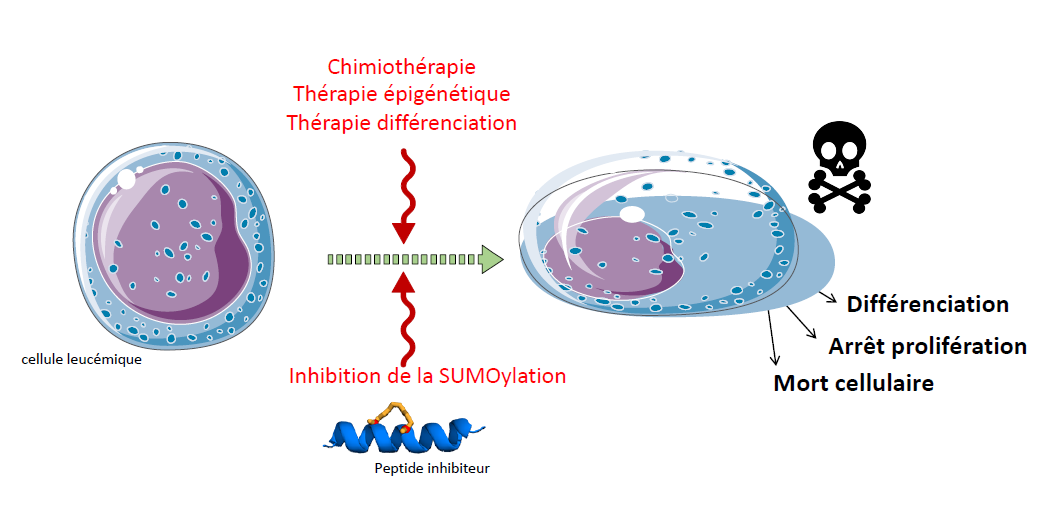A new therapeutic target for acute leukemia
At the heart of advances in the treatment of acute myeloid leukemia, the SUMOLAM project is well on the way to identifying a peptide capable of improving treatment efficacy. A medical challenge for this bone marrow cancer, which still kills three out of four patients. This project has received support from the I-SITE MUSE as part of its 2018 research program.

Finding a new treatment for acute myeloid leukemia. The medical stakes are high for this poorly treated bone marrow cancer, which accounts for 1% of all cancers in France. Although treatments are available, mostly based on intensive chemotherapy, most patients relapse. Today, 5-year survival is only about one in four. "What's more, chemotherapy is very cumbersome: half of all patients are not eligible for it because they are unable to tolerate it. And therapeutic progress has been limited over the past 50 years," explains Guillaume Bossis, Research Director at theMontpellier Institute of Molecular Genetics (University of Montpellier, CNRS). As part of the SUMOLAM project, which he has been directing for almost two years, he is working on a new therapeutic target to combat these leukemias.
This target is sumoylation*, a series of enzymatic reactions that block treatments. To understand this, you need to know that leukemia is linked to a proliferation of immature blood cells and a block in their differentiation. This prevents the normal production of red blood cells, white blood cells and platelets. Possible treatments for the disease include blocking their proliferation (chemotherapy) or restoring their differentiation (differentiation therapy). "Our first discovery was to show that sumoylation is involved in the response of leukemia to these two types of therapy", explains Guillaume Bossis. His team is proving in vitro that inhibition of sumoylation promotes the action of these treatments. To put this discovery to clinical use, inhibitors of sumoylation enzymes need to be found. This is the starting point for the SUMOLAM project.
The medical benefits of peptides
To set up the project, Guillaume Bossis has surrounded himself with several teams. Firstly, Muriel Amblard from the IBMM-Peptide laboratory based at the University of Montpellier. This peptide chemist has demonstrated the effectiveness of peptides in blocking enzymes. Then, to find the most effective peptides for clinical use, he teamed up with the Spanish team of María Lois from the University of Barcelona, who developed tests to analyze peptide activity. Over the last year and a half, the team's work in selecting and improving peptides has enabled them to test around 70 of them, and to find around ten that are effective inhibitors. For the best candidates, the team is seeking to further improve their efficacy by identifying peptide-enzyme bonds using crystallography, which will enable the peptide to be modified for the strongest possible chemical interaction.
"Peptides are still little used in medical research", explains the researcher, who points out the advantages of these molecules over chemical active ingredients, thanks to their good bioavailability and low toxicity. While the project is progressing well in vitro, tests on cells and then pre-clinical trials in a living organism must now confirm the peptides' activity. To this end, the team is working in collaboration with the Clinical Hematology Department of Montpellier University Hospital, headed by Guillaume Cartron, who is providing access to patient cells from the HémoDiag sample bank, which can be grafted onto mice for in vivo testing.
Two companion patents filed
In the medical research race, another player is vying to find a sumoylation inhibitor: the Japanese laboratory Takeda Pharmaceutical is currently conducting clinical studies for a chemical molecule. On the contrary, Guillaume Bossis is not dismayed: "The multiplication of effective treatments is necessary in view of leukemia cells' ability to resist treatment. A therapy combining several molecules targeting the same protein can help delay these resistance phenomena.
In view of the progress made, the team plans to file a patent on a sumoylation inhibitor by the end of the project. Two companion patents have already been filed, in particular a test to monitor inhibitor efficacy. As for the application of a new treatment for acute myeloid leukemia, the team is ready to go all the way if no laboratory takes over the testing phase, by creating an ad hoc start-up.
* Sumoylation is a series of enzymatic reactions that lead to the conjugation of the SUMO protein to thousands of proteins, modifying their function and fate.